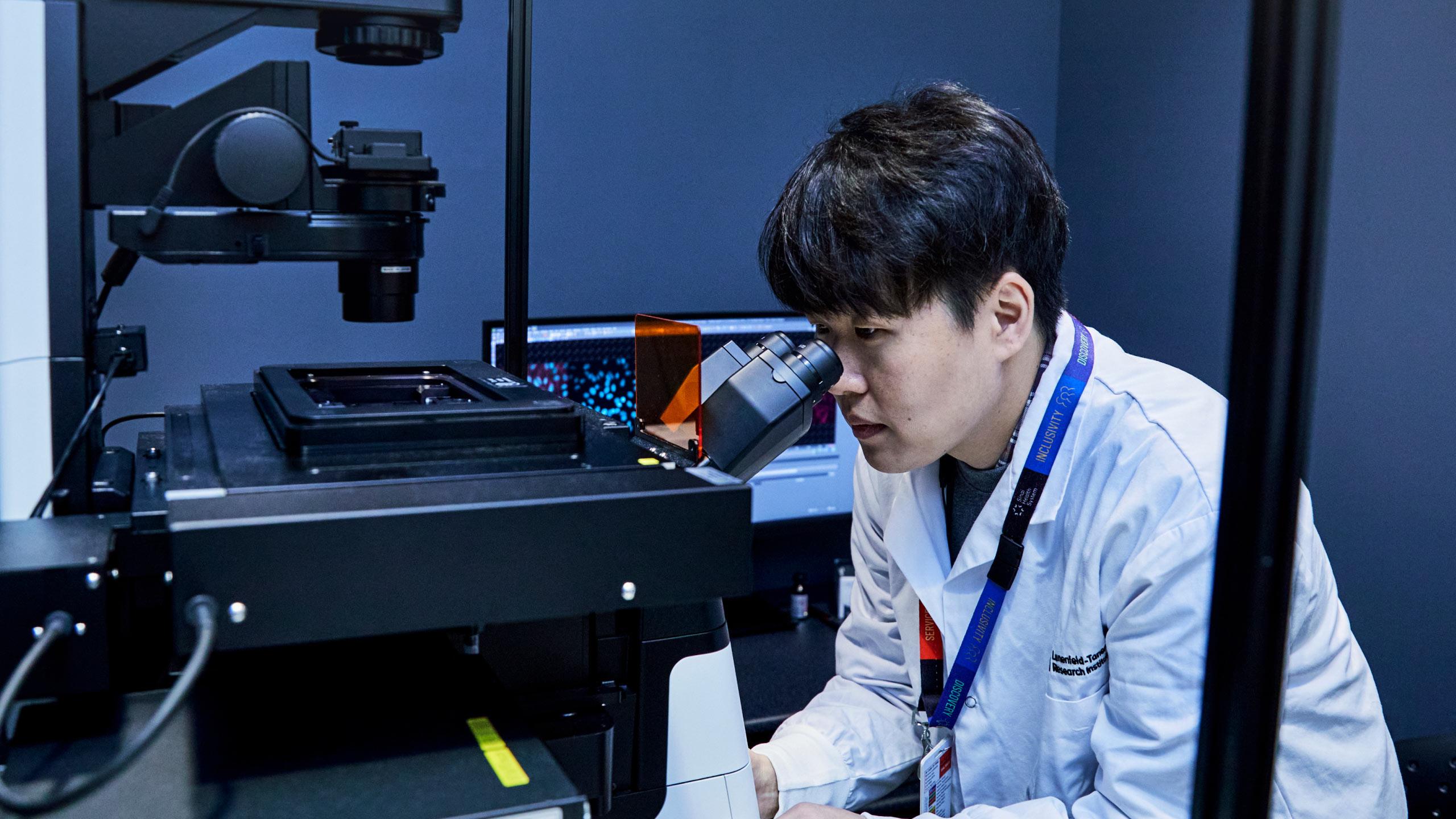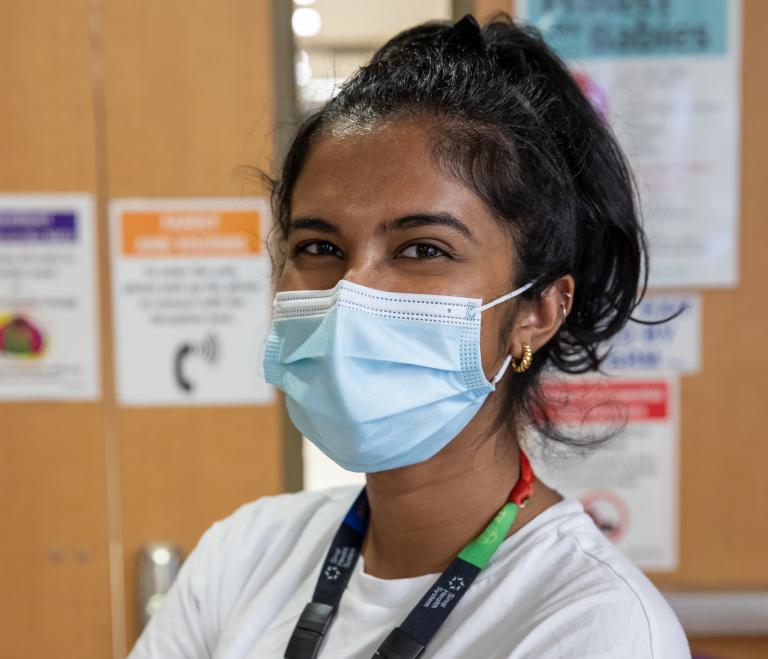Dentistry Education and Research
Education
Please visit University of Toronto’s Faculty of Dentistry for instructions on how to apply.
Available residency spots: 6
The Hospital Dental Residency is a dynamic, structured, program offering opportunities for patient care in most disciplines of dentistry in a unique hospital setting. You will interact with full- and part-time staff who will expend considerable time and energy to ensure that you have a positive educational experience during your residency year. We believe that we have the premier hospital dental residency program in Canada and one of the top international programs.
The Department of Dentistry is an integral member of Mount Sinai Hospital's health care facility. We are members of a large and successful interactive community within which there is a significant degree of interdependence. Four of our key programs, Oral Facial Pain (including the surgical management of the TMJ); Dentistry for Persons with Disabilities and Medically Compromised; the Graduate Program in Oral and Maxillofacial Surgery and the Clinical Program in Oral Pathology and Oral Medicine are recognized as core programs of the hospital and are the primary provincial sites for such specialized care.
Our hospital community includes nurses, administrative, custodial, medical and dental personnel, undergraduate dental and graduate specialty students, and you the full-time resident staff. Communication and co-operation is the key to our success as a department. We are a united team committed to quality patient care in an educational environment.
The patient is the single most important person at the Mount Sinai Hospital and is the focus of our attention. The majority of our patients are medically compromised and this fact alone will offer considerable educational and treatment challenges. Our patients are seen only on a referral basis either from physicians, dentists or other dental specialists. We are a tertiary and quaternary treatment facility in the heart of the University of Toronto’s Health Sciences Complex.
There are mandatory in-hospital educational and patient care rotations including day, evening, weekend emergency coverage, sessions in anesthesia, ENT, dentistry for persons with disabilities, facial and TMJ pain, general dentistry, oral and maxillofacial surgery, oral pathology and oral medicine, periodontics, prosthodontics including implants for special needs patients, and endodontics. There are also weekly seminars requiring your active participation. Out of hospital rotations include patient care at the Toronto Rehab the largest rehab facility in Canada and Weeneebayco Hospital in Moose Factory Ontario.
The academic year at Mount Sinai offers an exciting, dynamic educational experience for the motivated resident in hospital dentistry providing you are willing to commit all your time and energy to this program. Upon completion of our program, you will be well prepared to enter a general practice, institutional practice or specialty programs in dentistry.
There are a number of mandatory rotations throughout the year:
- Two weeks in anesthesia
- One week ER medical rotation
- One week ENT
- Two months at Toronto Rehab
- Three weeks at Moose Factory and coastal dental treatment facilities
- One week at Princess Margaret Hospital for dental oncology
You will be assigned to various departmental programs such as oral and maxillofacial surgery, emergency and general dentistry on a master yearly schedule. It is not possible to change these assignments unless you have the permission of the director of the residency program. In a similar fashion, vacation time (you are given three weeks’ vacation during the year) must be pre-booked at the beginning of the year. Changes cannot be made unless you have the permission of the director of the residency program. Time needed for interviews or other matters can be taken but will be considered "vacation time". Every effort is made to have you attend periodic continuing education meetings throughout the year.
You will be assigned to our emergency dental service on a "one in six" basis. This means that by the time the year is over, you will have spent about one-sixth of your time covering the emergency service. The hospital dental resident is always called first for all patients who are admitted to the emergency department. The residents from the Graduate Program in Oral and Maxillofacial Surgery will also be on call for major emergencies such as fractures or major fascial space infections. The hospital dental residents will be on call and play an active role in all emergency cases, including those under the care of the Graduate OMFS program. However, it is possible, and most likely, that you will cover several "shifts" in a row before having several days where you will be off the emergency service. It is possible to make changes to your emergency "shift" amongst yourselves without prior administrative approval. There are three emergency shifts: daytime, evenings from17:00 to midnight and midnight to 08:00, and weekends to which you will be assigned by our clinic manager. In addition, you will be on call when you are assigned to your oral and maxillofacial surgery rotation for active patients admitted to that service under your care.
The nature of our program usually precludes your active participation in any of our ongoing research projects. Our program does not offer electives in other areas of interest. Our program does support your interest in obtaining certification in the provision of sedation in your future practices. There will be seminars on intravenous sedation as well as ongoing experience in providing this anesthesia service to our clinic patients. Furthermore, you will be assisting staff oral and maxillofacial surgeons with intravenous sedation cases in the clinic. There may be other opportunities to further your experience in anesthesia "after hours" should you wish to pursue this option.
Our program in dentistry for persons with disabilities is very active and will provide you with a rich and rewarding experience in all respects, including comprehensive care under general anesthesia. We are the only hospital with a major clinical oral pathology and oral medicine university teaching program in which all residents participate. We are developing a clinical implant program for the residents and an enhanced program in periodontal surgical care for medically compromised individuals. All of these clinical activities will be a challenge. We do not offer experience in pediatric dentistry except when in Moose Factory, or in orthodontics.
Occasionally, it may appear as if significant demands are being made on your time, however, that is what this program is all about. You will have many opportunities to participate in interesting patient care situations which can occur at any time as we are a 24 / 7 program. You will interact with graduate students and residents in various medical and dental specialties.
Co-Directors of Program: Dr. Mary-Ellen Cascone, Dr. Maria Colaiacovo and Dr. Bruce Freeman
The Advanced Training Program in Craniofacial Pain Management has been developed to accommodate an ever-increasing patient volume and increased complexity of cases in craniofacial pain. This multidisciplinary educational program integrates several areas of pain dentistry including, oral and maxillofacial surgery, oral medicine, endodontics, periodontics, prosthodontics, orthodontics, oral and maxillofacial pathology, and geriatric dentistry.
The Advanced Training Program in Craniofacial Pain Management follows an evidence-based approach based on clinical research/critical appraisal to address adult chronic, non-cancer pain in craniofacial region. This program has been defined as a one full year educational period.
The Advanced Training Program in Craniofacial Pain Management is a collaboration between members of the University of Toronto at the Faculties of Dentistry and Medicine, as well as Mount Sinai Hospital. Upon completion of the program, the trainees are expected to: Describe craniofacial pain in the context of multi-disciplinary and patient-centered health care setting. They can also able to critically appraise clinical research related to craniofacial pain management to enhance evidence-based clinical decision making. Furthermore, the participants may recognize and respond to ethical issues arising in managing patients with craniofacial pain. Finally they will be able to contribute to the research activities; apply knowledge of the clinical, socio-behavioral, and fundamental biomedical sciences relevant to craniofacial pain.
This program is only open to internationally trained dentists.
For more information, please visit the University of Toronto’s Faculty of Dentistry.
Update in Dentistry
Cutting-Edge Innovations: Transforming Patient Care
Friday, November 1, 2024 - The Old Mill Toronto
Learn about the latest developments across all dental specialties during this jam-packed, one-day conference revolving around a central theme.
Visit the Temerty Faculty of Medicine to learn more and register.
Research
Mount Sinai's dental professionals share their published articles that highlight important findings and insights within dentistry.
Published on: December 30th, 2016
Report summary: Effects of enamel matrix derivative on non-surgical management of peri-implant mucositis: a double-blind randomized clinical trial.
IADR abstract submission - Unique CD marker signatures of oral neutrophils in refractory and chronic periodontitis
Published on: March 29th, 2019
Report summary: Radiographic and clinical measures (probing depths, bone loss) shown in patients with RP mimic similar measures derived from patients with severe CP (apart from the severity and rapidity of bone loss in the former). However, our findings suggest that the two conditions could be manifested, at least from the point of view of innate immunity, by wholly different pathophysiological mechanisms. At the least, these findings also support the notion that RP and CP should be classified as separate entities, as has been alluded to by the new American Academy of Periodontology (AAP) classification system.
Music medicine and jaw muscle motor response
Published on: February 28, 2018
Report summary: Our program sees many patients who have various forms of pain in their head and neck region. The pains can include tooth-pain, headache, migraine and neuralgias. But one of the most common types of pain (that can also trigger headaches for example) is related to something called temporomandibular disorder (TMD). This is characterized by painful jaw movement, pain with chewing, and other pain complaints. Interestingly, some of these patients with TMD have increased pain when they grind or clench their teeth. Our work shows that there might be significant improvement in clenching when patients are treated using Music Medicine. This could have important benefits for patients with TMD whose pain is worsened with jaw movement and in particular clenching and grinding.
Periodontal health and gingival diseases
Published on: December 9th, 2018
Report summary: There is increasing recognition that various conditions affect the gum tissues and these range from ‘routine’ gingivitis (redness of gums and bleeding with brushing) to other more significant skin conditions that are also affecting gum tissues (gum tissue being more or less a specialized type of skin).
Published on: December 4th, 2017
Report summary: The anti-Inflammatory actions of an intra-oral adhesive patch containing botanical extracts exert inhibitory effects on the development of dental biofilm and improved clinical outcomes in the management of peri-Implant mucosal inflammation and peri-implantitis.
Published on: May 3rd, 2018
Report summary: We are becoming increasingly aware that for prevention and management of dental diseases such as tooth decay and gum disease, we must focus more specifically on the causes of these conditions as opposed to only treating them when they occur. In the past we've relied heavily on the twice a year recall and also our hopes that patients would follow our instructions regarding how to clean their mouths. Unfortunately, many patients just can't seem to get used to using the methods for oral care at home (e.g. flossing). Hence, we are now focusing on the delivery of preventive care that, apart from requiring patients to adhere to a routine recall appointment schedule, helps them to maintain better oral health, even if they find it difficult to adhere to the oral hygiene instructions we give them to perform at home. In in this case we have demonstrated that gum disease, which didn't respond to routine treatment could be improved by use of a dental drug, Prevora, which was actually developed to prevent decay. In fact, we are now looking at this drug for treatment of patients who are at high risk for the development of dental decay as well as oral infections and gum inflammation, who have a history of oral cancer and radiation therapy, people on mouth-drying drugs, people with dry mouth syndromes, as well as adults with special needs for whom home care can be difficult to impossible.
Published on: March 4th, 2016
Report summary: Systemic treatment with resveratrol and/or curcumin reduces the progression of experimental periodontitis in rats.
Resveratrol induces healing of periodontitis in mice
Published on: June 7th, 2018
Report Summary: Resveratrol derivative-rich melinjo seed extract, that have antioxidant and anti-inflammatory properties, accelerated healing of periodontal bone and tissue destruction and that these effects are related to decreases in oxidative stress and osteoclast activity.
The Department of Dentistry focuses on the latest research and news related to dental health.
Daily Mail: Poor oral health may increase increase risk of diabetes study warns
By Jaleesa Baulkman
Overview:
Our patient population generally is at higher risk for development of oral diseases including dental decay and gum disease; both of which can lead to loss of teeth as well as the development of pain. There is also groundswell of evidence showing that poor oral health will have a negative effect on overall health. For instance, it is now recognized that various forms of gum disease can make treatment of diabetes more difficult. Interestingly, the presence of diabetes, if poorly controlled, also seems to interfere with treatment of gum diseases. Now there is growing evidence that people who have gum disease might even have a higher risk for the development of heart disease, although a cause and effect relationship has yet to be established.
Our Model for Periodontal and Peri-Implant Disease Progression
Overview:
Development of a model for how periodontal and peri-implant diseases might progress. We believe that there are bacterial triggers, but that after this, host responses and other factors, possibly even including migration of titanium ions or particles into tissues surrounding implants. We are hypothesizing that these particles could contribute to ongoing inflammation, even if bacterial infection is controlled. This could explain why management of peri-implant diseases is more difficult than management of periodontal conditions (about teeth).
Reference: by Mount Sinai Dentistry
Overview:
There is an increasing amount of evidence suggesting that poor oral health might be a risk factor or indicator for development of other non-oral problems ranging from diabetes to cardiovascular disease. However we don’t understand the biological reasons for this in full. However, in this study, it is shown quite clearly that even if we do not quite understand how oral and general health are linked, there are still important benefits related to the delivery of oral healthcare! This article shows how the addition of dental healthcare dramatically reduces the costs for treatment required for other diseases such as diabetes. The findings also show that complications from these conditions that would otherwise require hospitalizations are reduced when dental care is also provided. So regardless of how these are linked, we know that when oral health is maintained, there are important improvements in other conditions with marked reductions in overall healthcare costs as well as a reduction in hospitalization.
Reference: by Kamyar Nasseh, Marko Vujicic, and Michael Glick









